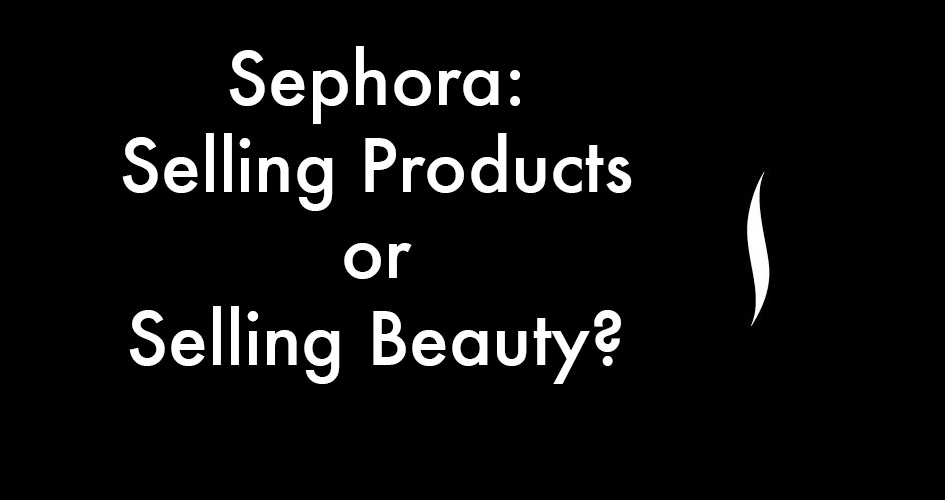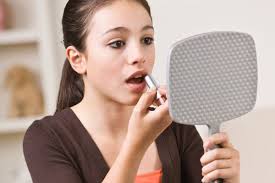 |
|
| By: Melina Cantu |
 |
|
| By: Melina Cantu |
| In 1998, Sephora came over from France and revolutionized the makeup industry in the United States. They are well known throughout the country as being the only chain store of it's kind. Their focus on makeup products and their recognition as being the only chain store to provide the variety of it's kind has given them the title of being the "beauty authority". But what makes something beautiful really? While some people might find beauty to be the things that make us all different, others might argue that beauty is the definition created by the consumer world as something that is pleasing to the eye created through the use of aesthetic products. Since Sephora is an international company dedicated to selling aesthetic products, it comes to no surprise that their main marketing strategy is linking beauty to makeup. |
| We live in a society where the use of makeup in women is a vital part of their lives. Our society has ingrained the idea that as women, we need makeup to be beautiful. When discussing makeup, author Carole Jackson is also a believer of makeup being essential to beauty, "When I was a young girl, I wanted so much to be pretty. Studying myself in the mirror, I saw a pale, colorless face and decided that I really wasn't pretty at all. After having my coloring analyzed by a professional color consultant, I found that I do not look pale and lifeless after all -- as long as I wear color that brings out the glow of my natural coloring" (Jackson 9). Our society tells us that we need color to be beautiful, and this color comes through the use of makeup. Here Jackson elaborates on the key areas to focus on, "Each of us have a unique skin tone. Finding the colors that best compliment this tone brings out our special beauty" (Jackson 10). Just like this author, many women grow up believing ideas such as these that without color/makeup one is not beautiful. We see how this concept of beauty is exploited in the ways in which Sephora labels items and areas of their store as "beauty" items and areas. | |||||||||||||||||||||||||||||||||||||||||||||||||||
 |
This site will be dedicated to the use of discourse analysis II to reveal how Sephora manipulates the idea of beauty comes from using makeup into selling the products they provide in the store. A discourse II analysis "works with similar sorts of materials (like in discourse I, visual images and written or spoken text) but is much more concerned with their production by, and their reiteration of, particular institutions and their practices, and their production of particular human subjects. This difference can be clarified by looking at how two exponents of these two kind of discourse analysis use the term 'archive'" (Rose 227). This will dissect the different ways in which Sephora links beauty to makeup through how they present and advertise their products within the store, and name the makeup studio in their store as the "beauty studio". Lastly this site will also go into the way in which Sephora groups items together and labels them as "beauty to go". |
| The idea that makeup is what makes someone beautiful has been one engraved already into our heads and Sephora is merely using this to their advantage. A social psychological study conducted proved that "Male peers who judged the photographs of women wearing their typical cosmetics deemed them to be more physically attractive than men who saw them without their cosmetics...Our results provide clear evidence that these college women's body images were more favorable with their customary cosmetics than without them" (Dawson 354). Based on this study we can see how cosmetics/makeup are viewed as products that make one beautiful. The idea of beauty is one that is very important and relevant in our society, that it affects our daily lives; "The 70% of the world's female population refrains from the ordinary living activities (giving their opinions, dating with their boyfriends, performing a physical activity, going to school and work or going to an interview) due to their dislike of their appearances"(Kar 17). One can interpret this as proof that beauty is an important aspect of life therefore being beautiful is essential. Women have come to believe and incorporate these ideas into their life, "Many women who say at least some makeup is essential express their feelings that wearing makeup is indeed as important part of being dressed" (Beausoleil 52). The importance based on the usage of makeup has become an essential part of how women view themselves today. This concept has been so perpetrated into women's minds seen in this example, "You know when I just want to give myself a lift, when I put on lipstick I look better...many women say that when they look better, they feel better" (Beausoleil 52). Putting on makeup makes women feel better about themselves and helps achieve that goal of lifting their self esteem. |  |
| The use of cosmetics among women has become an important practice in today's society. Our society has made makeup into a necessary component of a woman's identity to such extreme that many women have come to need it not only to conform with social norms but for self esteem as well. In a study made by Kirsten Dellinger, this idea was expressed by the women she studied, "In fact, many women in the sample say they wear makeup because it makes them feel confident about themselves." (Dellinger 158). Basically, if these women don't use makeup they're not as confident, consequently having a lower self esteem than if they were wearing makeup. These are several ways in which see how society has manipulated the women into buying the concept of achieving beauty through makeup. |
| Sephora is a store full of products advertised to boost someone's physical beauty. Although Sephora does not carry all cosmetic brands, it does have an extensive selection of brands to fulfill the needs of all the different types of customers that are in the market for aesthetic products. Discourse Analysis II allows us to see how Sephora exploits the relevance of makeup being tied to beauty in how they shape and model their store in a way that the consumer believes this to be fact. Sephora, like most stores, participates in a system of institutional technologies. Institutional technologies are "the practical techniques used to practise that power/knowledge. Technologies are 'diffuse, rarely formulated in continuous, systematic discourse.. often made up of bits and pieces.. a disparate set of tools and methods'" (Rose 230). Since Sephora is a store that specializes in aesthetic products, it applies the technology of display by having "display cases which are mounted either on the walls or tables and open displays with no protective cover" (Rose 243). By having the products uncased, it makes the items accessible to consumer. Another aspect we see is the textual and visual technologies of interpretation, such as the labels and captions, which make their products into objects. This technology can be tied to the technological layout because there is relevance in "the relations established between elements in the room, and writes to convey the effect of their combination" (Rose 247). For example, Sephora separates products according to how well they're selling. This is accomplished by proper labeling, captions, and where the products is displayed in the store. All of these different technologies are used together to attract a certain type of customer. The customer "is constituted as an 'eye': someone who sees, and through seeing, understands in specific ways"(Rose 251). All of these concepts are put together by Sephora to create the idea that using these products will make whoever is using them beautiful. |
| Rose, Gillian. Visual Methodologies: An Introduction to Researching with Visual Materials. London: SAGE, 2012. Print. | Dellinger, Kirsten. "Makeup at Work: Negotiating Appearance Rules in the Workplace." Gender and Society 11.2 (1997): 151-77. JSTOR. Web. 05 May 2014. | Beausoleil, Natalie. Many Mirrors: Body Image and Social Relations. Ed. Nicole Landry. Sault. New Brunswick, NJ: Rutgers UP, 1994. Print. | İnceoğlu, Yasemin, and Altan Kar. "New Beauty Icons: Freedom Or Conviction To The Human Body." Ileti-S-Im 10 (2009): 7-31. Communication & Mass Media Complete. Web. 24 Apr. 2014. | Cash, T. F., Dawson, K., Davis, P., Bowen, M., & Galumbeck, C. (1989). Effects of Cosmetics Use on the Physical Attractiveness and Body Image of American College Women. Journal Of Social Psychology, 129(3), 349. | Jackson, Carole. "The Magic Of Color." Introduction. Color Me Beautiful: Discover Your Natural Beauty through the Colors That Make You Look Great & Feel Fabulous! Washington: Acropolis, 1980. 9-10. Print. | sweetpastels.wordpress.com www.mom2bbreviews.com |
a class taught by Bob Bednar in the Communication Studies Department at Southwestern University